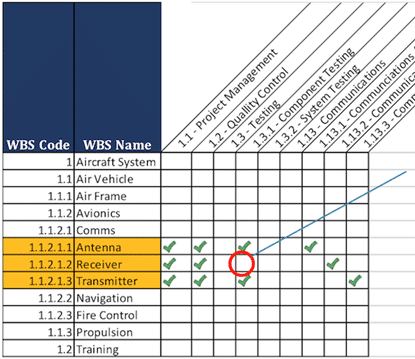
One of the pillars of every project is the Work Breakdown Structure (WBS) and the associated WBS dictionary. Whether you are a contractor presenting the project baseline or the client reviewing it, the WBS and WBS Dictionary are your Rosetta Stone for understanding how the different pieces of a project will ultimately come together.

The WBS is the hierarchical subdivision of the project based on deliverables. It is the actual structure that we are used to seeing and using to organize the project. It allows us to break down the scope into managaeble pieces and provides a reporting structure that we use for planning, performance monitoring and actual costs.
The WBS Dictionary
The WBS Dictionary, in addition to expanding the simple discription of the WBS elements, connects the WBS to the Statement of Work (SOW). The WBS dictionary is usually a spreadsheet that lists the WBS, the WBS element name, and a description of the work done in that element. A good dictionary will also have a field indicating which SOW paragraph is covered by that WBS element.


The Link Between WBS and SOW
The last column in the example shows how the lowest level elements of the WBS relate to the SOW. In the example, you can see that each element is related to different paragraphs in the SOW. This link shows that the project will plan, execute, and capture the actual project management costs associated with each individual element.
What does this link achieve?
Linking these two structures allows you to view your project in different dimensions, providing many reporting and analysis opportunities. It can quickly tell you whether you have everything covered in the SOW or are doing work in a WBS element that is not covered by the contract.
But that’s just the beginning. By looking at the relationships that exist between WBS elements, you can see how different SOW paragraphs are linked and whether that makes sense or not. In addition, performance and actual costs can be assigned to SOW paragraphs. The visibility of this is still valuable.
Conclusion
Used properly, the WBS dictionary becomes much more than a document describing work. It becomes a project kaleidoscope that allows you to view your project data in an infinite number of ways.
Understanding the WBS and the WBS Dictionary is essential to successfully managing a project. It provides a clear overview and in-depth understanding of how each part of the project comes together. It is a tool that should not be overlooked by project managers and stakeholders.


In the world of project management, risk management is often overlooked or simplified. But at Baeken we know that it is much more than a side benefit. It is crucial part of any successful project.
An integrated approach
With every project comes risks, and that requires risk management. This is not just a task for the project manager, but for the entire team. It involves identifying, analyzing and evaluating the risk and its potential impact.

Mitigation plan
A risk mitigation plan is not just a reactive document; it is a proactive approach to limiting potential damage. At Baeken we define risk events as events that could have a negative or positive impact on the project.
Identification process
Identifying risks is a layered and dynamic process. It is not only about identifying possible problems, but also about creative and organized thinking. This includes brainstorming all possible risks that could negatively or positively impact the project.

Detailed Process
Risks do not arise in a vacuum; they can be traced, understoof and evaluated. Checklists, based on previous experiences, are a core part of the Baeken methodology and a valuable tool in identifying potential risks.
Risk Assessment
Risks are not all the same, and at Baeken we categorize them into domains such as technical, human, financial, and more, so that we can thoroughly evaluate and manage them.
Monte Carlo Simulation
This statistical method goes beyond superficial calculations; it provides an in-depth simulation of possible outcomes and helps the Baeken team make accurate projection of risk events.
Risk Mitigation
At Baeken, risk mitigation is not standard practice; it is a customized strategy that takes into account various factors such as risk avoidance, risk sharing and more.
Contingency Plan
We believe in flexibility and preparation. Our contingency plans are not backups but essential components to achieving project goals, even in the face of unforeseen risks.
Risk management at Baeken is more than a process; it is a philosophy. We are aware of the complexity and versatility it entails. With our broad approach and commitment to quality, we are a reliable partner for successful project management.
